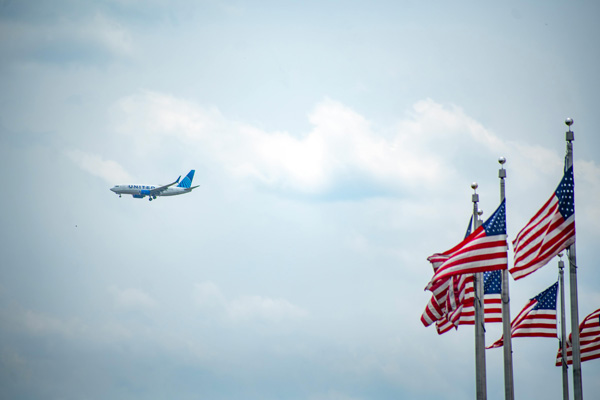Trump accepts $400M Qatari jet amid $1B retrofit concerns

[An aircraft flying through the sky with U.S. flags in the background. Photo credit: Pexels]
President Donald Trump’s decision to accept a $400 million luxury jet from Qatar as a substitute for Air Force One has drawn intense scrutiny from economic analysts and national security experts, raising concerns about the financial costs and foreign policy implications.
The aircraft, a Boeing 747-8, was originally offered by the Qatari government amid ongoing delays in the delivery of two new Air Force One planes already under contract with Boeing.
While Qatar framed the move as a goodwill gesture, the decision has become a flashpoint in Washington, where legal and strategic questions now dominate the conversation.
If accepted without Congressional approval, the jet would become the largest gift ever received from a foreign government by the United States.
That fact alone raises red flags under the Constitution’s Emoluments Clause, which prohibits federal officials from accepting gifts from foreign states without explicit legislative consent.
Historically, U.S. presidents have handled foreign gifts with caution.
During the Obama administration, defense collaborations like countries like Japan were conducted through official channels, with no personal gifts accepted.
Any items of value were either transferred to the National Archives or purchased at appraised value.
Under George W. Bush, high-value gifts from Saudi royals, such as a $10,000 watch, were similarly processed under the Foreign Gifts and Decorations Act, ensuring legal compliance and avoiding conflicts of interest.
Although the Trump administration has emphasized that the aircraft is being offered to the Department of Defense rather than to the president personally, critics argue the optics remain problematic.
From an economic standpoint, the potential cost of converting the jet to meet Air Force One’s rigorous security and communications standards could be as high as $1 billion.
Necessary upgrades include missile defense systems, encrypted communication networks, and reinforced structural protections required for any aircraft operating as Air Force One.
The Department of Defense would be responsible for funding these modifications, meaning American taxpayers would bear the financial burden.
This comes as the U.S. has already committed billions toward completing two new Air Force One aircraft scheduled for delivery in 2027.
Even routine operating costs would strain government resources.
Maintaining a crew for a presidential aircraft can exceed $30 million annually, and the total yearly operating costs can climb above $130 million.
Experts argue that integrating a foreign aircraft into this system would complicate budgeting and logistics, potentially creating long-term inefficiencies.
The market conditions surrounding the aircraft also factor into the controversy.
Boeing 747s, though once a staple of international air travel, have fallen out of favor due to high fuel consumption and limited operational flexibility compared to newer models.
Qatar reportedly struggled to find a buyer for the jet, which had been customized for VIP use and was unsuitable for commercial airline operations.
With few interested parties, the offer to the United States may have represented an opportunity for Qatar to offload an otherwise stagnant asset.
That economic calculus, paired with the scale of the gift, has prompted deeper concern that the move is less about diplomacy and more about leverage.
Geopolitical dimensions add further complexity.
Qatar, a wealthy but geographically small Gulf nation, has long used its financial resources to expand its influence on the global stage.
From defense contracts to foreign real estate and sports investments, Doha has pursued a soft power strategy that now seems to extend to direct engagement with the U.S. presidency.
Air Force One is a powerful symbol of national sovereignty and leadership.
Allowing a foreign state to contribute such a critical element of presidential infrastructure sets a precedent that could be interpreted as compromising.
Adding to the controversy is a lack of consistent messaging.
While U.S. officials have described the plane as a donation, Qatari representatives refer to a “possible transfer of an aircraft for temporary use,” suggesting that final terms are still under negotiation.
This lack of clarity fuels speculation about the motivations and long-term expectations behind the deal.
Further, the decision fits into a broader pattern during Trump’s presidency in which traditional diplomatic and ethical norms are frequently challenged or reinterpreted.
From military alliances to economic treaties, the administration has often adopted a transactional approach to international engagement.
Critics view the jet controversy as another example of prioritizing immediate utility over institutional integrity, while supporters argue it demonstrates pragmatic problem-solving in the face of bureaucratic delays.
Foreign policy observers warn that even the appearance of undue foreign influence could undermine U.S. credibility abroad.
As the debate continues, it remains unclear whether the Qatari jet will ever be used for presidential travel.

- Julian Yoo / Grade 11
- BC Collegiate (Upper School)

![THE HERALD STUDENT REPORTERS [US]](/assets/images/logo_student_us.png)
![THE HERALD STUDENT REPORTERS [Canada]](/assets/images/logo_student_ca.png)
